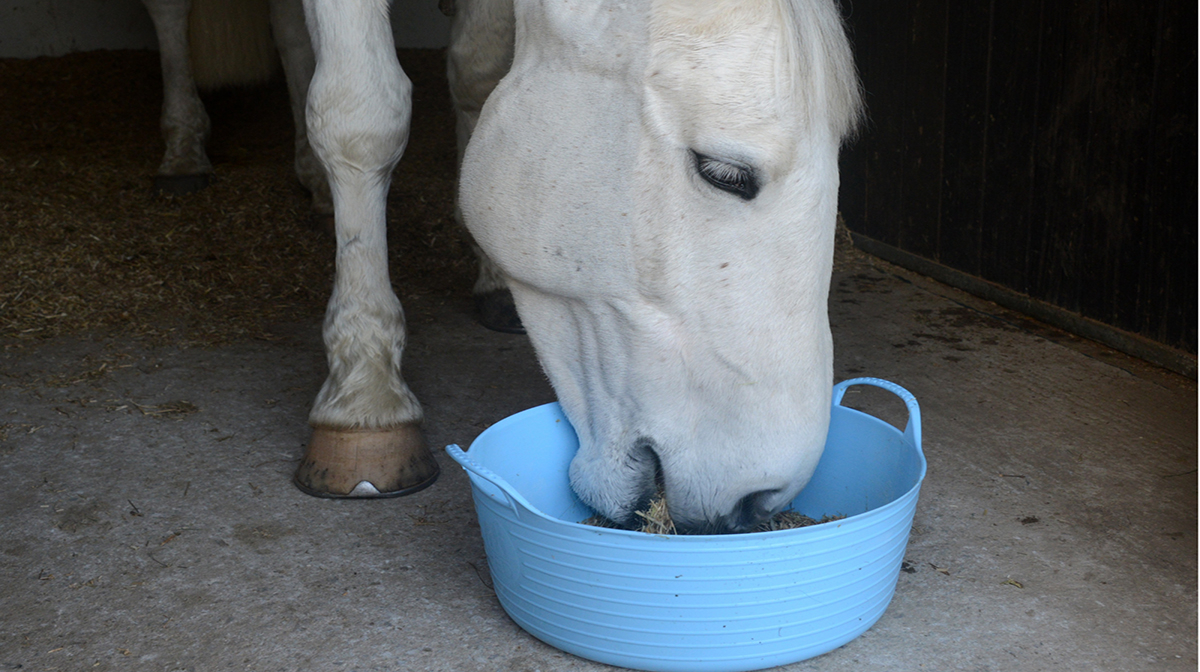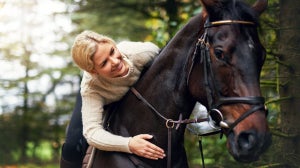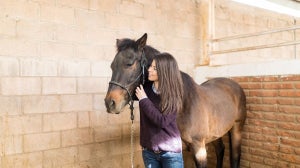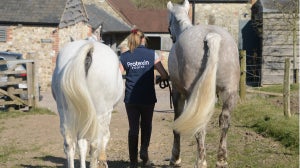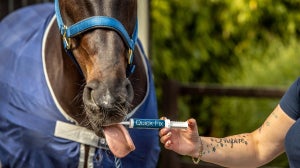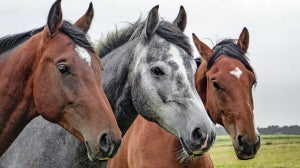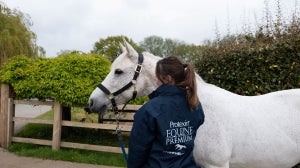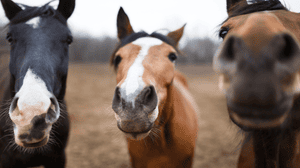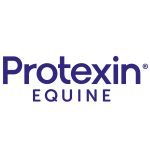
Understanding and supporting weight management for horses
Introduction
Effective weight management for horses is essential as it directly influences their health, performance, well-being and overall life span.
Obesity is linked with metabolic conditions (such as Insulin Dysregulation [ID], Equine Metabolic Syndrome [EMS] and laminitis), strain on joints and tendons and potentially respiratory complications. The Blue Cross reports equine obesity is rising and approximately 50 to 70 percent of horses and ponies are overweight (depending on the population)
Here are ways to move towards managing your horse’s weight more effectively.
1. Weigh your horse
Regularly weigh your horse to monitor changes and adjust their diet accordingly.
By using a combination of weight and body condition scoring (see point 2) you can best monitor your horse's weight fluctuations, allowing you to promptly adjust their diet and feeding rate if required.
Weight measurement is most accurate when a weighbridge is used. Often your local veterinary practice or feed company representative will bring one to yard visits, and this can often be requested for individuals. Regular use of a weighbridge gives consistent, accurate results of huge benefit for measuring your horse’s weight.
When a weighbridge is not available, a weight tape is a quick and easy tool to approximate weight, although this will not be as accurate as using a weighbridge. It can be useful if you want to determine overall trends in your horse’s weight (such as going up, going down, or staying roughly the same)
Early detection of weight changes enable you to adjust your horse's diet, ensuring optimal condition year-round, as feeding rates for forage, and most concentrate feeds, are tailored to body weight.
Both using a weighbridge and/or a weigh tape are best combined with carrying out body condition scoring
2. Monitor your horse’s body condition score (BCS)
You can regularly assess your horse's body condition using models like the Body Condition Score (BCS), which can evaluate body fat, muscle mass and overall health. The score can inform calorie intake, diet, and exercise routines for maintaining optimal health and weight. Ideally, monitor your horse’s body condition score every two weeks to ensure diet and exercise align with their workload and condition.
To use the BCS, start by scoring the pelvis, then adjust by half a point if there's a difference of one point or more to the back or neck.
Here is a general guideline for adjusting feeding rates based on BCS , as recommended by The British Horse Society:
For overweight horses: Feed forage at a ratio of 2% - 1.5%, while ensuring continuous forage is provided throughout the day. Avoid dropping below 1.5% without guidance from your vet.
For underweight horses: If your horse is underweight and no health issues are apparent, increase the percentage between 2.5% - 3%. You can consider higher calorie forage or additional concentrate feeds if needed.
3. Tailor a balanced diet with your vet/equine nutritionist
Your vet or equine nutritionist can help you determine what feed suits your horse best and how much and often you need to be feeding them.
Horses must be supplied with a sufficient supply of water, fibre, carbohydrates, fats and protein which in turn helps maintain your horse’s gut health. Access to fresh water, a constant supply of high-quality forage, and frequent small meals (if needed) should be easily accessible for your horse.
Regular monitoring of your horse’s weight and condition allows you to adjust feeding quantities if necessary, whilst considering their ongoing activity levels and environmental factors.
4. Practise portion control
If your horse requires hard feed consider splitting into smaller portions throughout the day, feed little and often as this will help with digestion.
Careful management of cereal-based feeds is essential to avoid issues like laminitis and colic caused by excessive starch consumption.
5. Limit your horse’s grazing
For weight control and metabolic health, you can limit grazing to prevent excessive sugar and carbohydrate intake, especially on lush pastures.
The British Horse Society recommends a minimum of 0.4-0.6 hectares per horse for permanent grazing, according to the horse’s size, weight, stabling duration and pasture quality. Consider a track grazing system (see below).
If your vet recommends limiting access to grazing, avoid turning your horse out onto lush, fresh grass and consider alternative grazing. It is worth considering the use of a grazing muzzle if you have limited options.
6. Provide your horse high-quality forage
Although hay and haylage are the most commonly fed forages, there may be a need to include other forages such as straw (up to 30%), dried cut grass, grass nuts or short chopped fibres into the ration. For example, a small amount of straw can be added into the diet of overweight horses, whereas soakable fibres may be useful for older horses with dental problems. Whichever forage you are feeding, it is essential that it is good quality and free of dust and mould.
7. Tailor a regular exercise routine with your vet/trainer
You can tailor an exercise routine based on each horse's fitness level, condition, age, and the available facilities with your vet/trainer.
Maintain a consistent exercise routine, to burn calories and build muscle, typically this would comprise of ridden exercise which may include hacking or school work. of your horse cannot be ridden, lunging, long reining, and hand walking can also contribute to weight loss. Especially for those experiencing metabolic disturbances, consider implementing a track grazing system to both help with grazing control and subsequent increased movement.
Exercise can improve glucose uptake by horse’s muscles, lower blood sugar, and boost overall fitness.
If your horse has undergone a period where exercise has been restricted (such as a bout of laminitis) then only start a supervised exercise regime after a veterinary examination to make sure your horse is comfortable and suitable to be worked.
8. Understand Equine Metabolic Syndrome (EMS) in your horse
Horses with Equine Metabolic Syndrome (EMS) tend to suffer from insulin dysregulation, regional fat deposits (adiposity), obesity, a reduced weight loss capability, and are at a higher risk of laminitis.
Equine Metabolic Syndrome (EMS) is reversible, yet due to the complexity of the condition, horses tend to experience difficulty in losing weight, unless they do more strenuous exercise.
A standard treatment consists of reducing calorie intake and raising physical activity, which can improve your horse’s insulin sensitivity and promote weight loss. Consult your vet for a diagnosis and treatment plan.
9. Evaluate the need for and limit over-rugging your horse
Horses tend to naturally develop a thick winter coat, some breeds better than others, native ponies have an enhanced ability to deal with adverse weather whereas breeds such as thoroughbreds will require additional support throughout the colder months. Therefore it's essential to evaluate whether rugging is necessary, based on seasonal temperature and your horse’s condition and breed. .
Horses have a broader thermoneutral range (5°C to 25°C) than humans, which lets them maintain core body temperature with minimal energy expenditure. However, when temperatures fall or rise beyond this range, horses need to increase their metabolism to regulate their body temperature through warming or sweating.
The winter season is a good opportunity for horses to lose weight naturally without excessive rugging. Any excess calories will be used to maintain warmth rather than being stored as surplus fat.
10. Explore enrichment options for slowing down consumption
Providing outdoor or stable enrichment can boost your horse’s physical and mental well-being. Enrichment methods such as trickle feeders and hay/treat balls encourage natural foraging behaviour and slow down consumption rates. You can also mineral salt or flavoured horse lick inside your stable to help with further natural vitamin and mineral support as well as enrichment.
FAQs
What is the best exercise for horses to lose weight?
Consult your vet beforehand to tailor a fitness programme for your horse. As a general guideline, there are three phases of horse fitness, as outlined by the British Horse Society:
Phase One: Introducing gradual exercise.
Phase Two: Improving upon basic fitness and strength.
Phase Three: Longer sessions to improve heart and lung efficiency.
Exercise is essential for horses. This can include activities like walking, lunging, using a horse-walker, or working over poles. By creating a track system in the field, you can encourage more movement compared to a traditional paddock setup.
How should we feed overweight horses?
Forage is the most important aspect of a horse's diet and particular attention should be paid to this when feeding an overweight horse.
Generally, we should aim to feed forage that equates to 1.5% body weight (when forage is dry). For example, a 400kg horse would be fed 400 x 1.5% = 6kgs forage dry matter. This 6kg would be fed over the course of the day, assuming there is no other feed and zero grazing. If the horse is grazing at pasture, the amount of fed hay should be reduced. If dry hay is fed, we would feed 1.5% of their body weight, but if soaked hay is fed, we would increase this to 1.8% of bodyweight. This forage should be fed throughout the day so can be split into multiple hay nets, nets can be doubled up to help reduce speed of consumption.
Additionally, up to 30% of the hay ration can be replaced with straw to assist with weight loss; this should be done very gradually to allow time for the horse to adjust to its new feed.
What can I use to help my horse gain weight?
If your horse needs to gain weight it is worth contacting a nutritionist to consider your options. They may recommend adding a concentrate feed or potentially including oil in the diet (such as linseed oil). As with any diet change, make changes slowly to avoid dietary upset. Conclusion
In summary, effective weight management for horses involves providing tailored nutrition, exercise, and regular monitoring. By following these tips, you can help your horse maintain a healthy weight for peak performance and overall health.
Remember to first consult your vet or equine nutritionist for guidance specific to your horse’s condition and health.

